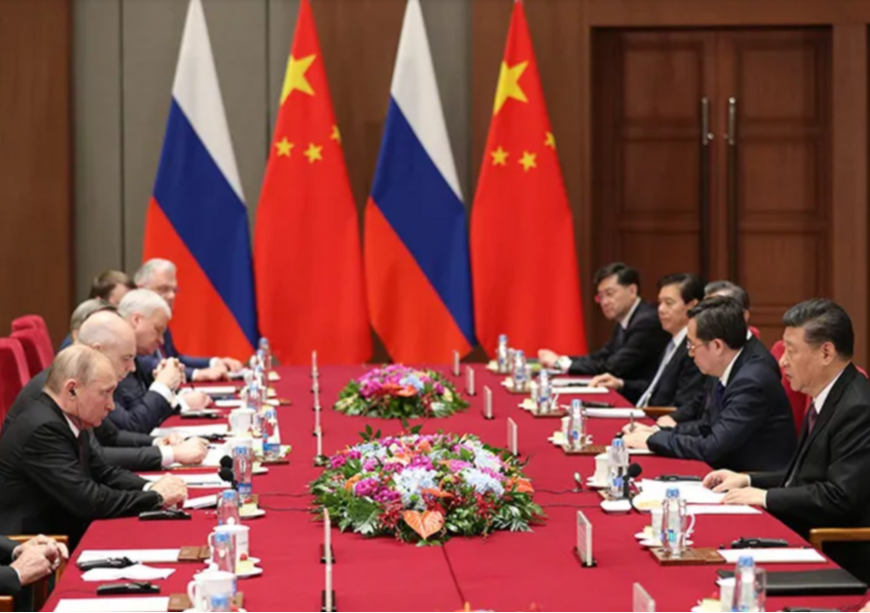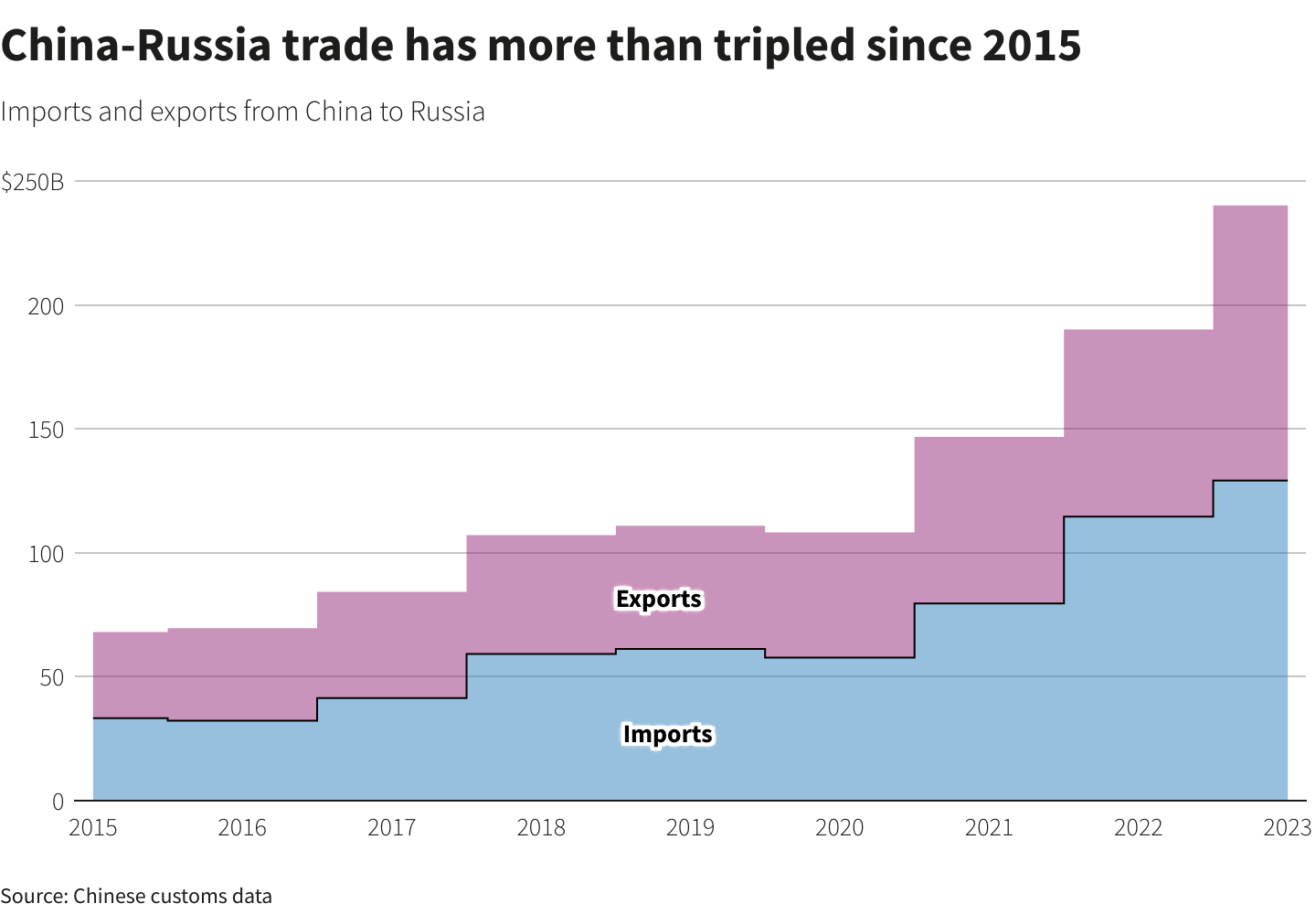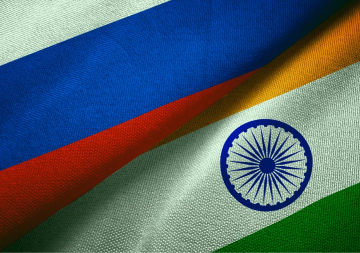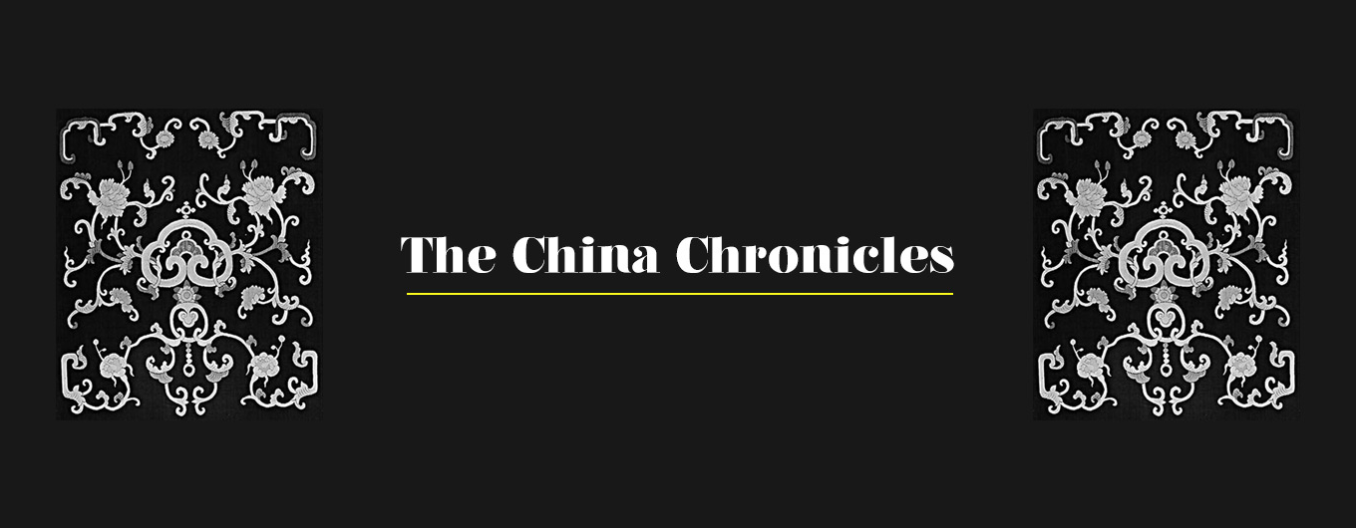
This is the 156th in the series–The China Chronicles.
On 25 April, while addressing the congress of the Russian Union of Industrialists and Entrepreneurs (RSPP), the Russian President, Vladimir Putin, announced that he would visit China in May to meet Chinese President Xi Jinping. This imminent visit to China could be President Putin’s first visit abroad since his re-election this March. This year marks the 75th anniversary of bilateral relations between the two nations. In 2022, days before the invasion of Ukraine, President Xi Jinping and Putin released a joint statement which concluded a “no-limits” partnership between the two nations to intensify friendship and bilateral cooperation.. Understanding the nature of Russia-China relations is imperative, given the importance of the global balance of power.
Why is the Russia-China dyad important?
Russia and China have mutually exclusive geopolitical interests. China is in long-term competition with the United States (US) and wants to thwart Western influence in the Indo-Pacific. Russia needs China in its larger ambitions of transforming the Greater Eurasian continent into a continental common space of peace, stability, and prosperity as Russia aims to pivot from Europe and concentrate on Eurasia. Therefore, from the second decade of the 2000s, Western-led isolation, though partial, began. One could observe an increased interaction between Russia and China through organisations such as the BRICS and Shanghai Cooperation Organisation (SCO). Russia backs China’s aspirations to create an alternative geo-economic landscape, which could be witnessed in China’s Belt and Road Initiative. A strong economic integration of the Eurasian region through multi-modal transit corridors and trade routes such as the Western Europe–Western China International Transit Corridor and the China–Mongolia–Russia economic corridor can increase trade across the region.
The ties between the two countries could be inferred as a highly strategic partnership in economic cooperation, humanitarian assistance, and military spheres. However, it's essential to recognise that while significant, this partnership should not be misconstrued as an alliance.
China-Russia bilateral developments
Because Russia is isolated from the West, China has emerged as a significant economic partner of Russia. Bilateral trade surpassed the US$200 billion target in 2023 at US$240. Trade has increased by 26.3 percent as compared to 2022 (See graph 1). Energy constitutes the majority of China’s imports. China surpassed Germany as the largest buyer of Russian energy. China purchased 107 million tonnes of oil in 2023, 24 percent more than in 2022. Gas deliveries through the Power of Siberia pipeline increased from 15.4 billion cubic meters in 2022 to 22.7 bcm. With a second Power of Siberia pipeline, which is to be constructed, it could deliver an additional 50 bcm of natural gas, and the gas trade will only increase as Russia attempts to move its natural gas value chains from Europe to Asia.
Gas deliveries through the Power of Siberia pipeline increased from 15.4 billion cubic meters in 2022 to 22.7 bcm. With a second Power of Siberia pipeline, which is to be constructed, it could deliver an additional 50 bcm of natural gas, and the gas trade will only increase as Russia attempts to move its natural gas value chains from Europe to Asia.
Chinese imports from Russia include copper, copper ore, timber, and seafood. Russia imports Chinese cars, smartphones, industrial machinery, and specialised equipment.
In December 2023, Mikhail Mishustin, the Prime Minister of the Russian Federation, hailed the China-Russia relationship as being “at the highest level in history” and described bilateral ties as “a ballast and stabiliser of international relations”.

Graph 1
Points of contention in Russia-China relations
The aftermath of the 12th package of sanctions announced by the European Union (EU) in December created additional restrictions, such as the secondary sanctions resulting in several Chinese banks refusing to process Ruble transactions from January, including the three largest Chinese banks: Bank of China, Industrial and Commercial Bank of China, and Construction Bank of China. Russian banks have opened their representative offices in China to process transactions to circumvent this.
The Chinese have expanded their military exports and industrial presence to subdue Congolese rebels in eastern DRC while securing mining rights and purchasing stakes in Congolese copper mines.
Further, the 13th package of EU sanctions, which has been in place since March, had forced Russian and Chinese companies to conduct parallel importation of goods. The tightening of screws and increasing transaction costs, could plateau the rapid growth in Russia-China trade that was seen last year.
According to Agathe Demarais, trade ties between Russia and China may be catching up from a very low base. Though increasing over the years, trade was underdeveloped until the Ukraine conflict. With sanctions curtailing Russia’s access to the European markets, Russia turned to China, fuelling a catch-up growth in the process.
China’s bilateral trade with the US in 2022 was US$758 billion, and China's trade with the EU exceeded US$850 billion. Chinese economic cooperation with the West is much higher than trade with Russia. So, the global perception of a “no-limits” partnership with Russia is not good for China’s image abroad, which, despite having aspirations to create an alternative world order with the help of Russia, is also bankrolling trade corridors that bypass Russia, such as the Middle Corridor. Furthermore, Beijing does not want to be seen as a nation that outrightly supports Putin’s geopolitical aspirations in Ukraine. Hence, a softer language has been employed by China in its communication with the West. Recently, Xi told US Secretary of State Antony Blinkin that the US and China should be partners and not rivals. Before Putin arrives in Beijing, President Xi will visit France. This shows that China is increasing its cooperation with the West. Therefore, over the years, strategic communities in Russia and China have refrained from using the term “no limits” when describing their bilateral relations. Thus, to resolve these perceived differences, President Putin is visiting Beijing.
Agenda for the present visit
The agenda of Putin’s visit to China will include resolving payment mechanisms between the two countries by deliberating the utilisation of national digital currencies or cryptocurrency payments to sustain bilateral trade. Further, discussions and agreements will likely be signed on the technicalities associated with commencing the construction of the Power of Siberia-2 pipeline. Further, the SCO and BRICS expansion process could also be on the agenda of Putin’s trip.
Conclusion Despite a strategic partnership, relations between Russia and China remain complex, with mutually exclusive goals and disagreements. Given New Delhi’s warm relations with Russia and deteriorating ties with China, it will carefully observe the developments. However, the outcome of the visit will not be surprising and may not create any excitement in the country. While no succinct term could label the nature of the Russia-China dyad, simplifying the partnership by calling it one with “no limits” must be avoided.
Rajoli Siddharth Jayaprakash is a Research Assistant with the Strategic Studies Programme at the Observer Research Foundation.
The views expressed above belong to the author(s). ORF research and analyses now available on Telegram! Click here to access our curated content — blogs, longforms and interviews.




 PREV
PREV



